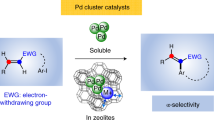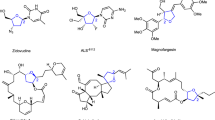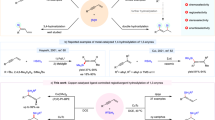Abstract
Hydroesterification reactions represent a fundamental type of carbonylation reaction and constitute one of the most important industrial applications of homogeneous catalysis. Over the past 70 years, numerous catalyst systems have been developed that allow for highly linear-selective (anti-Markovnikov) reactions and are used in industry to produce linear carboxylates starting from olefins. In contrast, a general catalyst system for Markovnikov-selective alkoxycarbonylation of aliphatic olefins remains unknown. In this paper, we show that a specific palladium catalyst system consisting of PdX2/N-phenylpyrrole phosphine (X, halide) catalyses the alkoxycarbonylation of various alkenes to give the branched esters in high selectivity (branched selectivity up to 91%). The observed (and unexpected) selectivity has been rationalized by density functional theory computation that includes a dispersion correction.
This is a preview of subscription content, access via your institution
Access options
Subscribe to this journal
Receive 12 print issues and online access
$259.00 per year
only $21.58 per issue
Buy this article
- Purchase on Springer Link
- Instant access to full article PDF
Prices may be subject to local taxes which are calculated during checkout



Similar content being viewed by others
References
Trost, B. M. Atom economy—a challenge for organic synthesis: homogeneous catalysis leads the way. Angew. Chem. Int. Ed. Engl. 34, 259–281 (1995).
Markownikoff, W. I. Ueber die Abhängigkeit der verschiedenen Vertretbarkeit des Radicalwasserstoffs in den isomeren Buttersäuren. Justus Liebigs Ann. Chem. 153, 228–259 (1870).
Huang, L., Arndt, M., Gooßen, K., Heydt, H. & Gooßen, L. J. Late transition metal-catalyzed hydroamination and hydroamidation. Chem. Rev. 115, 2596–2697 (2015).
Müller, T. E., Hultzsch, K. C., Yus, M., Foubelo, F. & Tada, M. Hydroamination: direct addition of amines to alkenes and alkynes. Chem. Rev. 108, 3795–3892 (2008).
Whittlesey, M. K. in Comprehensive Coordination Chemistry II (eds McCleverty, J. A. & Meyer, T. J.) 265–304 (Pergamon, 2003).
Müller, T. E. & Beller, M. Metal-initiated amination of alkenes and alkynes. Chem. Rev. 98, 675–704 (1998).
Beller, M., Seayad, J., Tillack, A. & Jiao, H. Catalytic Markovnikov and anti-Markovnikov functionalization of alkenes and alkynes: recent developments and trends. Angew. Chem. Int. Ed. 43, 3368–3398 (2004).
Mahatthananchai, J., Dumas, A. M. & Bode, J. W. Catalytic selective synthesis. Angew. Chem. Int. Ed. 51, 10954–10990 (2012).
Weissermel, K. & Arpe, H.-J. Industrial Organic Chemistry 127–144 (Wiley-VCH, 2008).
Kégl, T. in Modern Carbonylation Methods (ed Kollár, L.) 161–198 (Wiley-VCH, 2008).
Cornils, B. & Hermann, W. A. Applied Homogeneous Catalysis with Organometallic Compounds (Wiley-VCH, 2008).
El Ali, B. & Alper, H. in Handbook of Organopalladium Chemistry for Organic Synthesis (ed Negishi, E.-I.) 2333–2349 (John Wiley & Sons, 2003).
Franke, R., Selent, D. & Börner, A. Applied hydroformylation. Chem. Rev. 112, 5675–5732 (2012).
Ali, B. E. & Alper, H. in Transition Metals for Organic Synthesis (eds Beller, M. & Bolm, C.) 113–132 (Wiley-VCH, 2008).
Beller, M., Cornils, B., Frohning, C. D. & Kohlpaintner, C. W. Progress in hydroformylation and carbonylation. J. Mol. Catal. A 104, 17–85 (1995).
Jimenez Rodriguez, C., Foster, D. F., Eastham, G. R. & Cole-Hamilton, D. J. Highly selective formation of linear esters from terminal and internal alkenes catalysed by palladium complexes of bis-(di-tert-butylphosphinomethyl)benzene. Chem. Commun. 1720–1721 (2004).
Kiss, G. Palladium-catalyzed Reppe carbonylation. Chem. Rev. 101, 3435–3456 (2001).
Clegg, W. et al. Highly active and selective catalysts for the production of methyl propanoate via the methoxycarbonylation of ethene. Chem. Commun. 1877–1878 (1999).
Jamie, T. & Durrani, M. L. C. in Stereoselective Synthesis of Drugs and Natural Products (eds Andrushko, N. & Andrushko, V.) Part 2, Ch. 14 (John Wiley & Sons, 2013).
Noonan, G. M., Cobley, C. J., Mahoney, T. & Clarke, M. L. Rhodium/phospholane–phosphite catalysts give unusually high regioselectivity in the enantioselective hydroformylation of vinyl arenes. Chem. Commun. 50, 1475–1477 (2014).
Noonan, G. M., Fuentes, J. A., Cobley, C. J. & Clarke, M. L. An asymmetric hydroformylation catalyst that delivers branched aldehydes from alkyl alkenes. Angew. Chem. Int. Ed. 51, 2477–2480 (2012).
Klosin, J. & Landis, C. R. Ligands for practical rhodium-catalyzed asymmetric hydroformylation. Acc. Chem. Res. 40, 1251–1259 (2007).
Cavinato, G. & Toniolo, L. Metal in organic synthesis. VI. The solvent effect on the hydrocarbonalkoxylation of propene promoted by a [PdCl2(PPh3)2]−PPh3 catalyst precursor. J. Mol. Catal. 10, 161–170 (1981).
Rucklidge, A. J., Morris, G. E. & Cole-Hamilton, D. J. Methoxycarbonylation of vinyl acetate catalysed by palladium complexes of bis(ditertiarybutylphosphinomethyl)benzene and related ligands. Chem. Commun. 1176–1178 (2005).
Shuklov, I. A. et al. Promoters for Pd-catalyzed methoxycarbonylation of vinyl acetate. Arkivoc 66–75 (2012).
Frew, J. J. R., Clarke, M. L., Mayer, U., Van Rensburg, H. & Tooze, R. P. Palladium complexes of new bulky fluorinated diphosphines give particularly active and regioselective catalysts for hydroxycarbonylation of styrene. Dalton Trans. 1976–1978 (2008).
Fuentes, J. A., Slawin, A. M. Z. & Clarke, M. L. Application of palladium (trioxo-adamantyl cage phosphine)chloride complexes as catalysts for the alkoxycarbonylation of styrene; Pd catalysed tert-butoxycarbonylation of styrene. Catal. Sci. Technol. 2, 715–718 (2012).
Grabulosa, A., Frew, J. J. R., Fuentes, J. A., Slawin, A. M. Z. & Clarke, M. L. Palladium complexes of bulky ortho-trifluoromethylphenyl-substituted phosphines: unusually regioselective catalysts for the hydroxycarbonylation and alkoxycarbonylation of alkenes. J. Mol. Catal. A 330, 18–25 (2010).
Ooka, H., Inoue, T., Itsuno, S. & Tanaka, M. Highly active and selective palladium catalyst for hydroesterification of styrene and vinyl acetate promoted by polymeric sulfonic acids. Chem. Commun. 1173–1175 (2005).
Liu, J., Liu, Q., Franke, R., Jackstell, R. & Beller, M. Ligand-controlled palladium-catalyzed alkoxycarbonylation of allenes: regioselective synthesis of α,β- and β,γ-unsaturated esters. J. Am. Chem. Soc. 137, 8556–8563 (2015).
Konrad, T. M., Durrani, J. T., Cobley, C. J. & Clarke, M. L. Simultaneous control of regioselectivity and enantioselectivity in the hydroxycarbonylation and methoxycarbonylation of vinyl arenes. Chem. Commun. 49, 3306–3308 (2013).
Guiu, E. et al. Electronic effect of diphosphines on the regioselectivity of the palladium-catalyzed hydroesterification of styrene. Organometallics 25, 3102–3104 (2006).
Lee, C. W. & Alper, H. Hydroesterification of olefins catalyzed by Pd(OAc)2 immobilized on montmorillonite. J. Org. Chem. 60, 250–252 (1995).
Alper, H., Woell, J. B., Despeyroux, B. & Smith, D. J. H. The regiospecific palladium catalysed hydrocarboxylation of alkenes under mild conditions. Chem. Commun. 1270–1271 (1983).
Williams, D. B. G., Shaw, M. L., Green, M. J. & Holzapfel, C. W. Aluminum triflate as a highly active and efficient nonprotic cocatalyst in the palladium-catalyzed methoxycarbonylation reaction. Angew. Chem. Int. Ed. 47, 560–563 (2008).
Jørgensen, M., Lee, S., Liu, X., Wolkowski, J. P. & Hartwig, J. F. Efficient synthesis of α-aryl esters by room-temperature palladium-catalyzed coupling of aryl halides with ester enolates. J. Am. Chem. Soc. 124, 12557–12565 (2002).
Wender, P. A., Koehler, M. F. T. & Sendzik, M. A new synthetic approach to the C ring of known as well as novel bryostatin analogues. Org. Lett. 5, 4549–4552 (2003).
Crimmins, M. T., Carroll, C. A. & Wells, A. J. Pinacol-type rearrangements of intramolecular photocycloadducts: application of the 2,2-dimethyl-4-pentenoate protecting group. Tetrahedron Lett. 39, 7005–7008 (1998).
Gauthier, D., Lindhardt, A. T., Olsen, E. P. K., Overgaard, J. & Skrydstrup, T. In situ generated bulky palladium hydride complexes as catalysts for the efficient isomerization of olefins. Selective transformation of terminal alkenes to 2-alkenes. J. Am. Chem. Soc. 132, 7998–8009 (2010).
Larionov, E., Lin, L., Guénée, L. & Mazet, C. Scope and mechanism in palladium-catalyzed isomerizations of highly substituted allylic, homoallylic, and alkenyl alcohols. J. Am. Chem. Soc. 136, 16882–16894 (2014).
Grushin, V. V. Hydrido complexes of palladium. Chem. Rev. 96, 2011–2034 (1996).
Negishi, E.-I. in Handbook of Organopalladium Chemistry for Organic Synthesis (ed Negishi, E.-I.) 2783–2788 (John Wiley & Sons, 2003).
Elali, B. & Alper, H. Formic-acid palladium acetate-1,4-bis(diphenylphosphino)butane—an effective catalytic system for regioselective hydrocarboxylation of simple and functionalized olefins. J. Mol. Catal. 77, 7–13 (1992).
Pugh, R. I., Drent, E. & Pringle, P. G. Tandem isomerisation–carbonylation catalysis: highly active palladium(II) catalysts for the selective methoxycarbonylation of internal alkenes to linear esters. Chem. Commun. 1476–1477 (2001).
Surry, D. S. & Buchwald, S. L. Dialkylbiaryl phosphines in Pd-catalyzed amination: a user's guide. Chem. Sci. 2, 27–50 (2011).
Zapf, A. et al. Practical synthesis of new and highly efficient ligands for the Suzuki reaction of aryl chlorides. Chem. Commun. 38–39 (2004).
Chai, J.-D. & Head-Gordon, M. Long-range corrected hybrid density functionals with damped atom–atom dispersion corrections. Phys. Chem. Chem. Phys. 10, 6615–6620 (2008).
Kumar, M., Chaudhari, R. V., Subramaniam, B. & Jackson, T. A. Ligand effects on the regioselectivity of rhodium-catalyzed hydroformylation: density functional calculations illuminate the role of long-range noncovalent interactions. Organometallics 33, 4183–4191 (2014).
Acknowledgements
The Federal Ministry of Education and Research (BMBF) and Evonik Industries are acknowledged for their general support. K.D. acknowledges a Shanghai Institute of Organic Chemistry-Zhejiang Medicine joint fellowship for financial support. The analytic department of LIKAT is acknowledged. We are thankful to Q. Liu and X. Fang for the helpful and supportive discussions.
Author information
Authors and Affiliations
Contributions
M.B. and H.L. conceived and designed the experiments. H.L. and K.D. performed the experiments and analysed the data. H.J. performed the DFT study. H.N. and R.J. participated in the discussions and supported the project. M.B., H.J. and H.L. co-wrote the paper.
Corresponding author
Ethics declarations
Competing interests
The authors declare no competing financial interests.
Supplementary information
Supplementary information
Supplementary information (PDF 12038 kb)
Supplementary information
Crystallographic data for compound L15_2_PdCl2. (CIF 941 kb)
Rights and permissions
About this article
Cite this article
Li, H., Dong, K., Jiao, H. et al. The scope and mechanism of palladium-catalysed Markovnikov alkoxycarbonylation of alkenes. Nature Chem 8, 1159–1166 (2016). https://doi.org/10.1038/nchem.2586
Received:
Accepted:
Published:
Issue Date:
DOI: https://doi.org/10.1038/nchem.2586
This article is cited by
-
Palladium-catalyzed regiodivergent hydrochlorocarbonylation of alkenes for formation of acid chlorides
Nature Communications (2023)
-
Efficient access to aliphatic esters by photocatalyzed alkoxycarbonylation of alkenes with alkyloxalyl chlorides
Nature Communications (2021)
-
Highly active and efficient catalysts for alkoxycarbonylation of alkenes
Nature Communications (2017)



